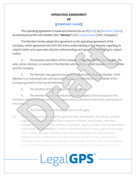Understanding E-commerce Terms & Conditions: A Comprehensive Guide
Navigating the sphere of e-commerce may sometimes feel like learning a foreign language. That's why, dear reader, we’re here to demystify it for you....
5 min read
LegalGPS : July 26, 2024 at 10:20 AM
As an e-commerce business owner, protecting your shoppers' privacy should be at the top of your to-do list. One effective way to accomplish that, while also fulfilling legal obligations, is to implement an e-commerce privacy statement. This key document will detail exactly what kind of personal data you collect from users, how you use this information, the steps you take to protect it, and much more.

Legal GPS templates are drafted by top startup attorneys and fully customizable.
If this task looms large and confusing, don’t worry. In this guide, we’ll simplify it for you!

You can consider an e-commerce privacy statement as your handshake agreement with shoppers. It’s a clearly defined document explaining the ins and outs of how you treat private customer data on your e-commerce platform. It is not just a suggestion, but rather, a legal requirement to have a privacy statement on e-commerce websites in most jurisdictions.
The goal? To foster transparency and build trust with your customers while staying compliant with laws like the GDPR or California’s CCPA.
Privacy statements can differ slightly from site to site due to variations in business practices, but generally, your e-commerce privacy statement should cover:
List out what type of data you collect from your visitors. This might include names, contact details, payment information, IP addresses, or browsing activity.
Explain what you do with this information. This may involve order processing, customer service, marketing communications, or business analyses.
Shoppers want to know that their data is safe. Tell them about your cybersecurity measures and how you store their data safely.
If you share data with third parties (like payment processors or marketing agencies), disclose this! Let your shoppers know who has access to their data and why.
Describe what tracking technologies you use (like cookies or pixels) and why you use them.
This section is about user control. Spell out what choices they have regarding their data, how they can opt-out of certain uses, or delete their information altogether.

Protect your business with our complete legal subscription service, designed by top startup attorneys.
A cookie-cutter template won't do the trick here. Every e-commerce business is unique, and so should be its privacy statement. So, here's your DIY guide!
Before you start drafting your privacy statement, you need to understand your own data practices. Analyze and identify:
What type of personal data you collect from users (e.g., name, contact details, payment information, IP addresses, browsing activity).
How you collect this information (e.g., forms, cookies, third-party tools).
How you use this information (e.g., order processing, customer service, marketing, research).
Make notes of each aspect of your data collection, storage, and usage policies to ensure you have a comprehensive understanding of your practices.
Example: Our privacy statement covers all personal data collected by [company name] from users and customers. We collect information that is necessary for us to provide our services and fulfill your order, including name, shipping address, email address, payment information. We also gather information about how you interact with our website or mobile app (e.g., browsing activity), which helps us improve our services and make them more relevant for you.
Once you've analyzed your data practices, organize your privacy statement into the following sections:
Introduction
Information Collected
Usage of Collected Information
Data Storage and Security
Third-Party Sharing and Usage
Cookies and Tracking Technologies
Customers' Rights and Choices
By providing a clear structure, you ensure that your customers can easily navigate and understand your privacy statement.
Example: Privacy Statement Introduction We are committed to protecting the privacy of our customers. This Privacy Statement explains how we collect and use information about you, including when you visit our website, mobile apps or other products or services (collectively, “Services”), or otherwise interact with us. By visiting or using our Services, you agree to be bound by this Privacy Statement. If you do not agree to be bound by this Privacy Statement at any time while using our Services, please stop using them immediately.
Now it's time to start writing! Remember to use clear, concise, and approachable language in each section of your privacy statement. Here are some tips for each section:
Introduction: Explain the purpose of your privacy statement and emphasize your commitment to privacy.
Information Collected: List the types of personal data you collect from users and explain the methods used to collect this information.
Usage of Collected Information: Detail how you use the collected data, including processing orders, customer service, marketing, or research.
Data Storage and Security: Describe the measures you take to ensure the security of user data, such as encryption, secure servers, or regular backups.
Third-Party Sharing and Usage: Disclose any third parties with whom you share user data and the purposes for which this data is shared.
Cookies and Tracking Technologies: Explain the tracking technologies (e.g., cookies or pixels) you use, how they work, and their purpose.
Customers' Rights and Choices: Describe the choices users have regarding their data, such as opting out of certain practices or requesting data deletion.
Example: “We use cookies, which are small files stored on your computer, to enable us to remember you and provide a more personalized experience. You can remove or block cookies using your browser settings, but in some cases doing so may affect your ability to access parts of our site. We do not store any personal information in cookies we place on your device.”
Get Your E-Commerce Privacy Statement Template
with a Legal GPS Subscription
After drafting your privacy statement, review it to ensure it complies with applicable privacy laws and regulations. These may vary depending on your location and target audience, so consult with a legal professional or use a legal guidance tool to help you identify and address relevant legal requirements.
Example: “We will not sell or rent your personal information to third parties. The only exception is that we may share personal information with trusted partners who assist us in providing our services. For example, if you purchase a product from us, we may share your name and payment information with the company that handles fulfillment of orders. Those parties are not allowed to use your personal information for any purpose other than carrying out the services they are performing for us.
Make your privacy statement visually appealing and easy to read. Break up text with bullet points, subheadings, and clear formatting. Ensure the statement is easily accessible from your website's navigation menu or footer.
Example: "We may share your personal information with third-party service providers that perform services on our behalf. For example, we may need to share your name and payment information with the company that handles fulfillment of orders."
Before making your privacy statement public, have it reviewed by a lawyer or legal service to ensure it's legally compliant, comprehensive, and accurate. This is a crucial step to avoid any potential issues or liabilities.
Example: "We may share your personal information with third-party service providers that perform services on our behalf. For example, we may need to share your name and payment information with the company that handles fulfillment of orders."
Privacy practices and regulations can change over time. Regularly review and update your privacy statement as needed, ensuring your customers have the most accurate and up-to-date information about your data policies.
By following these detailed steps, you can create an e-commerce privacy statement that resonates with your users, protects your business, and complies with the law.
Example: Here’s an example of a simple e-commerce privacy statement, which is compliant with GDPR regulations. It explains how your company handles personal data and includes details about how users can opt out of tracking:
While a custom-tailored privacy agreement is ideal, templates can indeed provide a solid starting point, especially for small businesses with simpler data practices. Reliable legal services providers offer online forms or wizards to help you cover the basics. If you're not sure where to start, check out our professionally crafted privacy statement for e-commerce businesses!
A transparent, well-crafted e-commerce privacy statement does not just keep you on the right side of the law, but it also builds trust with your customers. And we all know, in e-commerce, trust translates to sales!
Get Legal GPS's E-Commerce Privacy Statement Template Now

Protect your business with our complete legal subscription service, designed by top startup attorneys.

Navigating the sphere of e-commerce may sometimes feel like learning a foreign language. That's why, dear reader, we’re here to demystify it for you....

Navigating the world of business relationships can be a complex voyage. One essential tool to smooth your journey is the employment agreement. But...

When it comes to commercial leasing, there's a lot to consider for the everyday entrepreneur. One option that stands out among the rest is the Buyer...